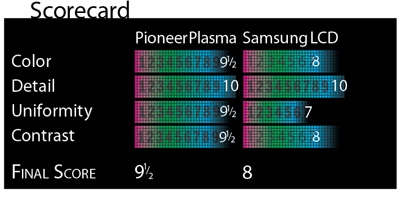Plasma vs. LCD: Round II Page 5

Al Griffin, Technical Editor A fresh comparison of flat-panel TVs is something we've had sitting on the back burner for a while now. Why? Because it took Samsung's 46-inch LN-T4681F to give us the confidence that a current LCD display could hold its own against plasma, much less the best plasma TV on the market.
After tweaking both TVs, I was awestruck by how closely matched their pictures were - the Samsung's really looked that good. It was only with detailed comparisons that we noted some of the LCD's flaws - a reddish cast to faces in Black Book, slightly toxic greens on the golf course in Happy Gilmore, a yellow tinge to snow-capped peaks in Vertical Limit (prompting the inevitable Frank Zappa joke from Mike Trei). In comparison, the Pioneer's color balance was close to perfect.
The Samsung set delivered the deepest shadows of any LCD I've tested. It's just that the Pioneer's blacks were appreciably deeper. In fact, the Pioneer's all-around knockout performance found us nodding to each other in the darkened room, uttering "Kuro" in hushed, reverent tones. Samsung has dramatically raised the bar for LCD TV performance, but the technology still has further to go.
Michael Trei, Contributing Technical Editor From the minute I walked into the room, I was impressed by how closely Al had matched the images on these two very different sets. Particularly with brighter scenes, the differences were subtle enough that they would be tough to spot under any circumstances - except in a side-by-side shootout like this one.
With most material, the Samsung LCD had a bit more punch in bright areas, but at the same time it tended to hype the color a bit - especially reds and greens. The Pioneer plasma couldn't quite match the LCD's dynamic pop, but its colors were clearly more subtle and realistic-looking. Once we moved to a few night scenes, though, it soon became clear that the plasma could deliver a substantially darker shade of black. The LCD was particularly sensitive to viewing angle as well, and the image quickly washed out as you moved off axis. While I clearly preferred the image the plasma could deliver in our light-controlled video lab, the LCD's added punch would probably be a plus in a room with a lot of light - that is, if the TV's shiny reflective screen surface weren't such a problem. Add it all up, and there's no question that plasma won the day.
Rob Sabin, Executive Editor As you've read, by the end of our several hours of evaluation, Al, Mike, and I all agreed that the plasma handily beat the LCD - especially in the key area of contrast. I'd also have to agree that LCD as a technology has plenty more growing to do, and hasn't yet shown us the best of what it's got.
But I think our results here have to be viewed in the context of the tremendous feat that Pioneer has accomplished with its new Kuro sets. The three of us evaluate HDTVs for a living, and we were all blown away by how virtually perfect this 50-inch Elite set was in its execution of every torture test we threw at it. "Best TV - ever" was a phrase heard more than once that day as it began to sink in just how good the darn thing was.
We have to throw a big bone to Samsung - in fact, a really big bone - for driving forward the state of the LCD art in a significant way, and for bringing a critical new advance (LED backlighting) down to an affordable price. That said, Samsung and all other flat-panel manufacturers in both disciplines now have a new gold standard by which to measure their work going forward. Kudos to Kuro.
Test Bench
Neither TV initially tracked terribly close to the 6,500-K spec for color temperature. In its Movie mode with Low color temp and Color Space Mode 2 settings, the Pioneer plasma ran as high as +1,599 K on the brightest 100-IRE window (that is, quite blue) and +436 K from 20 to 90 IRE. (See our full lab numbers on the Web.) The Samsung LCD, in Movie mode with Warm 2 color temp and Auto Color Space settings, tracked up to +995 K from 20 to 100 IRE, and +752 K from 30 to 100 IRE. Calibration by technical editor Al Griffin brought both to within about ±220 K at 100 IRE and within 150 K from 30 to 90 IRE - though in typical LCD fashion, the Samsung had more ups and downs and fell further off in the darkest 20-IRE window.
For our comparison, test gear was used to match both panels to a post-calibration brightness of 35 ftL, a comfortable setting for viewing in a dark room. It's worth noting that the Samsung LCD had the edge here in its inherent ability to pump out a bright image, though Al kept it reigned in to make things fair.
Primary colors for both sets measured essentially perfect across the board - a rarity for one TV, much less two. And color decoders were accurate, too, with both TVs showing a minor +2.5% error for red.
Although it didn't count in our face-off rankings, we noted a slight geometry aberration on the Samsung in its "bit-for-bit" Just Scan mode, with about 1 to 2% overscan evident on only the right side of its screen; the Pioneer plasma measured 0% all around. We also ran the Silicon Optix Benchmark tests on Blu-ray Disc and standard-definition DVD, and found the Pioneer's processing superior for deinterlacing both 1080i and 480i signals via HDMI. Read the Extended Test Bench
Read the Full Test Bench Read the first Plasma Vs. LCD Comparison Test Reports RSS Feed More Features More Test Reports Back to Homepage What's New on S&V

























































